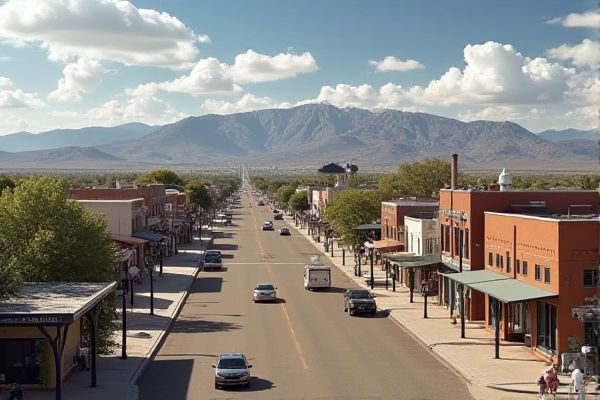
Weather and climate in New Mexico: Arid desert climate dominates. Four distinct seasons experienced. Hot summers, mild winters. Monsoon season: July-September. Elevation affects temperature variations. Low humidity levels. Frequent sunshine year-round. Occasional snowfall in northern areas. Windy conditions common in spring. Temperature extremes possible.
Arid desert climate dominates.
New Mexico is predominantly characterized by a semi-arid to arid climate, with most areas experiencing limited rainfall and high evaporation rates, especially in the southern and western desert regions where summer temperatures often exceed 100°F (38°C) and winters are mild. To learn more, visit the Tribal Climate Camp website. This distinctive climate influences the diverse and unique ecosystem found throughout the state, creating challenges in water management and conservation efforts.
Four distinct seasons experienced.
New Mexico experiences four distinct seasons, with warm and pleasant summers, cold winters with significant snow in the mountains, a windy and dusty spring, and a colorful and crisp fall. The climate varies significantly between the southern and northern parts of the state, influenced by elevation and geographic location. For more details on the unique weather patterns in this region, you can visit the IExplore website, which provides comprehensive travel guides and insights into this fascinating state's environment.
Hot summers, mild winters.
In New Mexico, summers are hot and dry, especially in the southern region where temperatures can reach into the 90s°F, while winters are mild in the south with daily highs around 60°F, but colder in the north with significant snowfall in the mountains. The state's climate varies significantly with elevation, with the northern areas experiencing colder winters and pleasant summers. For more detailed insights on the weather patterns and how they affect travel, visit the IExplore website for comprehensive travel guides.
Monsoon season: July-September.
The North American Monsoon System (NAMS) in New Mexico typically begins around July 3 in the southwest and July 9 in the central Rio Grande valley, bringing significant precipitation through September. This period is characterized by a shift in wind patterns, increased thunderstorms, and moisture transport from the Pacific Ocean, the Gulf of California, and the Gulf of Mexico, with July and August being the rainiest months. For more information on the monsoon system, you can visit the Weather.gov website.
Elevation affects temperature variations.
In New Mexico, elevation significantly influences temperature variations, with temperatures decreasing by about 5 degrees Fahrenheit (3 degrees Celsius) for every 1,000-foot (300-meter) increase in elevation, which is a more crucial factor than latitude. For more information on how elevation impacts the climate, check out the detailed study on New Mexico Climate from Encyclopedia Britannica.
Low humidity levels.
New Mexico is characterized by low humidity levels, with daily average relative humidity ranging from 44% in Albuquerque to 53% in Clayton, and afternoon humidity often dropping as low as 20-30% in various regions. The low humidity is particularly pronounced in the valleys, with humidity levels sometimes as low as 5%, and it has a significant cooling effect on nighttime temperatures due to rapid heat radiation. For more detailed information on humidity levels across different regions, visit the comprehensive resource on New Mexico Humidity.
Frequent sunshine year-round.
New Mexico experiences frequent sunshine year-round, with cities like Albuquerque and Roswell averaging around 278 sunny days per year, and the state receiving 75 to 80 percent of the possible sunshine, making it one of the sunniest places in the country. To explore more about the annual sunshine days in this sunny state, visit the detailed statistics provided by Current Results. This abundance of sunlight not only brightens up the landscape but also attracts visitors and residents who cherish outdoor activities and the clear skies typical of New Mexico.
Occasional snowfall in northern areas.
In New Mexico, occasional snowfall is prevalent in the northern and central regions, with the snow season running from November to March. Areas like Red River, Santa Fe, and Taos Ski Valley receive significant snowfall, with Red River being the snowiest place, averaging 40 inches of snow per year. For more detailed information, visit the Intrepid Travel website to discover more about the snowfall patterns and attractions in New Mexico during the winter months.
Windy conditions common in spring.
In New Mexico, the spring months, particularly April and May, with March and June also being significant, are the windiest due to the polar jet stream's influence and the increasing sun angle that heats the surface, leading to strong and turbulent winds. High wind events during this period can cause damage, reduce visibility due to blowing dust, and are often associated with strong surface pressure gradients and fronts.
Temperature extremes possible.
New Mexico experiences significant temperature extremes, with the all-time highest temperature recorded at 122°F on June 27, 1994, at the Waste Isolation Pilot Plant near Loving, and the all-time lowest temperature at -50°F on February 1, 1951, in Gavilan near Albuquerque. For more information on these incredible temperature records, visit the Most Extreme Temperatures in New Mexico History webpage.
